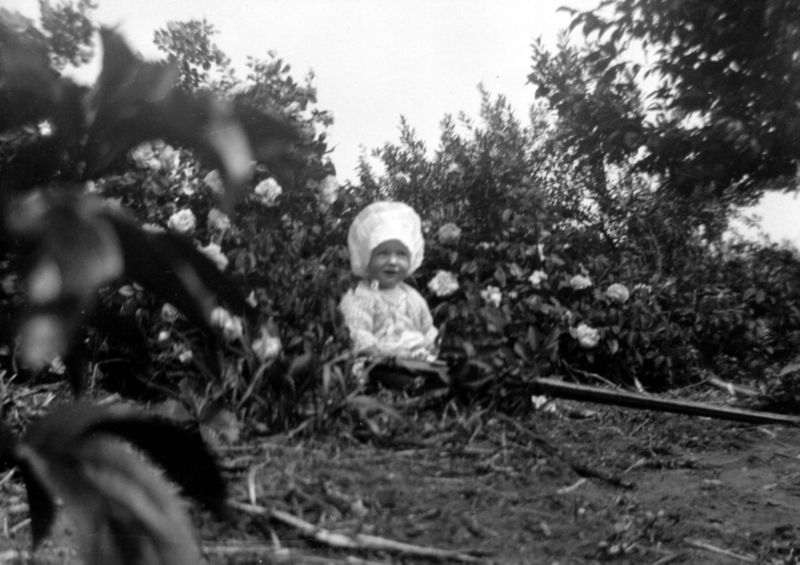Baby dressed nicely, sitting in a rose garden; appears to be 1930s. (more here)
Tag: 1930s
Radium Baths For Your Health
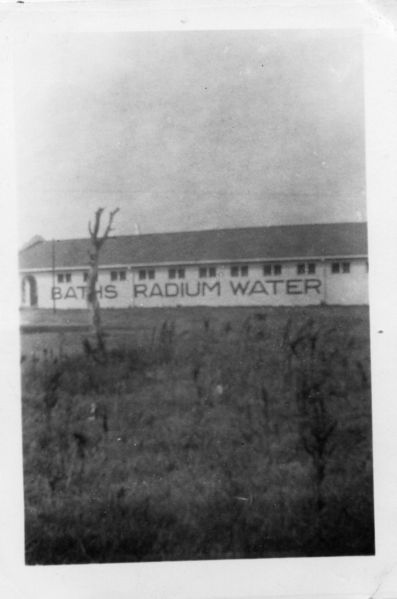 Combining bathing and radium doesn’t strike me as a wise idea: as the name alludes, radium is a highly radioactive element that decomposes into Radon, another not-so-healthful element. Back in the 1920s and 1930s, however, radioactive compounds were seen as quite the opposite: a curative, capable of curing pretty much whatever ails you. Radium was relatively stable (‘relatively’ when it comes to radioactive elements), common enough to be available to quacks everywhere, and just radioactive enough to not cause instant death. On top of it all, radium was naturally-occurring, and with the new radiation-detecting apparatuses developed at the beginning of the Atomic Age, people were amazed to find out just how much radiation existed around them. They began looking for hot-spots, and soon discovered that some of the natural mineral baths made a Geiger counter sound like a flamenco tapdancer.
Combining bathing and radium doesn’t strike me as a wise idea: as the name alludes, radium is a highly radioactive element that decomposes into Radon, another not-so-healthful element. Back in the 1920s and 1930s, however, radioactive compounds were seen as quite the opposite: a curative, capable of curing pretty much whatever ails you. Radium was relatively stable (‘relatively’ when it comes to radioactive elements), common enough to be available to quacks everywhere, and just radioactive enough to not cause instant death. On top of it all, radium was naturally-occurring, and with the new radiation-detecting apparatuses developed at the beginning of the Atomic Age, people were amazed to find out just how much radiation existed around them. They began looking for hot-spots, and soon discovered that some of the natural mineral baths made a Geiger counter sound like a flamenco tapdancer.
So, if you were interested in going to the spa, you might pass up on the average, non-radioactive hot-water mineral spa and visit a radium spa like the one on the right…while it wasn’t immediately deadly to casual users, the already-ill tended to continue to get sicker, so they used more radium-laced products, and got sicker, so they got more radium…you get the idea. Just going home wasn’t necessarily going to get you away from radium – if you couldn’t make it to the spa, you could irradiate your own water at home, or buy the stuff pre-packaged. All of these photos are slightly blurry — it makes me wonder just how much was the photographer, and how much was the proximity to radiation. That dead, scraggly tree in the foreground should have been a clue.
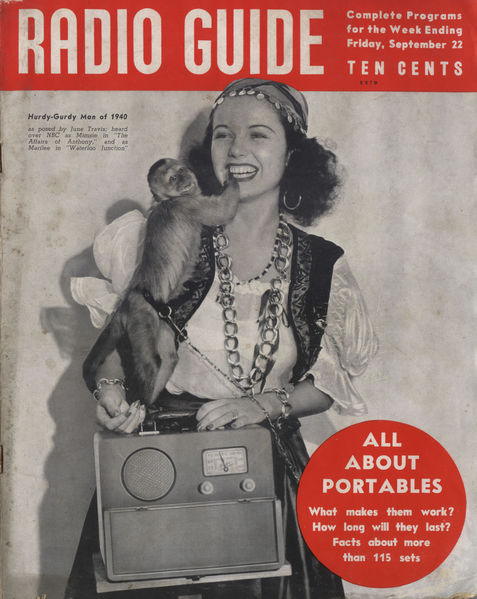 This is where it all started: you might argue that it was the portable record player, or the Walkman, or the laptop, or the iPod, but portable personal electronics started in the 1930s with the advent of portable radios. As a revolution, the cover shows just how large the jump was from the last comparable technology. The magazine compares a person carrying a portable radio to a hurdy-gurdy street performer. The concept of carrying around a small box of audible music was unbelievably new for the time — music boxes were one thing, but a broadcast receiver was beyond anything that had been seen before. It didn’t replace anything, like the lineage from cassette to CD to MP3; it struck out in uncharted territory.
This is where it all started: you might argue that it was the portable record player, or the Walkman, or the laptop, or the iPod, but portable personal electronics started in the 1930s with the advent of portable radios. As a revolution, the cover shows just how large the jump was from the last comparable technology. The magazine compares a person carrying a portable radio to a hurdy-gurdy street performer. The concept of carrying around a small box of audible music was unbelievably new for the time — music boxes were one thing, but a broadcast receiver was beyond anything that had been seen before. It didn’t replace anything, like the lineage from cassette to CD to MP3; it struck out in uncharted territory.
Battery powered equipment was not new; before mains were run to homes, everything was either battery-powered or hand-powered. The advent here is miniaturization. Vacuum tubes were the size of a fingertip and required far less electricity to run their internal parts than ever before, and smaller compact batteries had the oomph to power them. This continues to be the focus of today’s portables: how much can you fit into the smallest case? The article in the magazine reads, on one hand, like it’s been transcribed and word-replaced every year for the past hundred: Now you can take it with you, smaller technology improves weight and portability, new power sources get you longer operation times, includes headphones for private listening, and people are integrating it into their daily lives. The details are delightfully dated, but are easily echoed with modern technology. Celphone users can immediately sympathize with a person of 1930 seeking a a signal while deep inside a steel-structured building. People still attend sports events with a media-receiver, to not only see the event live but get up-to-the-minute commentary from outside sources. And, lastly — a point that the article emphasizes without divining the social cost — people demand the ability to take their personal, in-home media with them wherever they go. As the adage goes, the times may change, but people will remain the same, whether they’ve got a 10-pound AM radio slung over their shoulder or a fully-featured computer in their pocket.
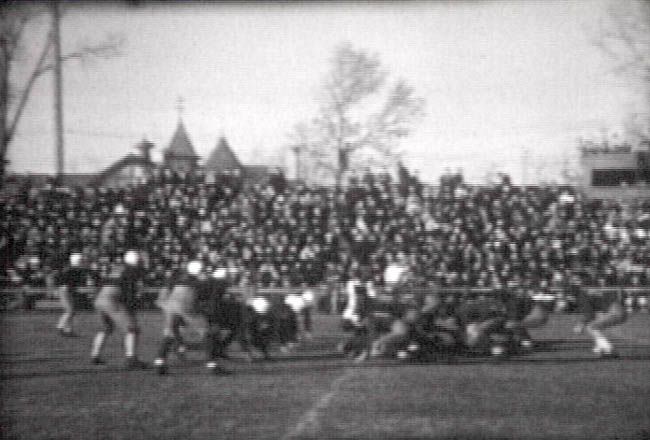
Yeah, you could consider this a tie-in to the new movie Leatherheads (opening today across the country!), but it’s as good an excuse as any to show an old movie of leather-helmeted football I own. The video linked above was part of a very small film-reel from the late 1920s or early 1930s; it couldn’t be any earlier, because the buildings depicted weren’t around before 1927. The first 80% of the film is an Armistice Day parade, which, of course, sets the date as November 11th. The last few minutes of the film, however, shows the Fargo-Grand Forks football game that evening, held on NDSU’s football field. Not much is shown, however it’s probably the oldest movie of North Dakota high school football on the internet. Sure, it doesn’t have any George Clooney, but it’s real high school football, the way it once was: full of bruised faces.
Bob, Flipo, and Elmer
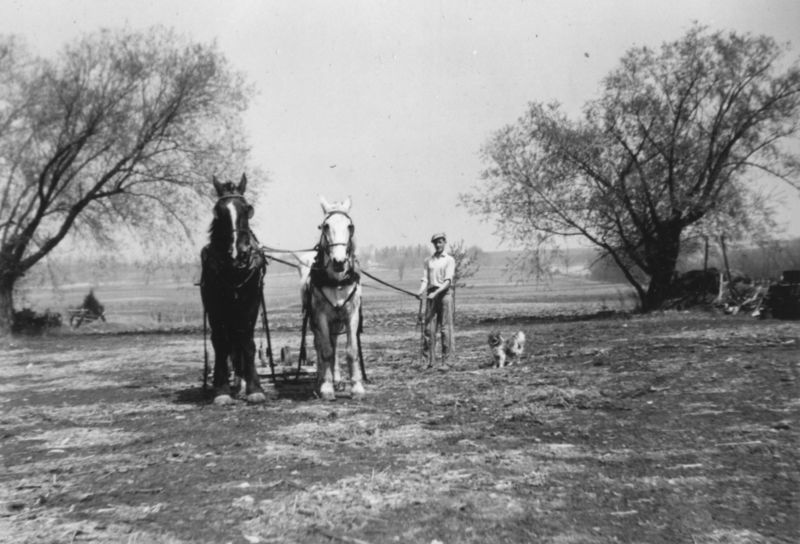 This photo was titled, “Bob, Flipo, and Elmer.” However, we’ve got four entities in the photo: Two horses, a man, and a dog. So, who’s who? Elsewhere in the album, we’ve met an “Elm“, which is probably short for Elmer, and a Brownie, that looks a bit like this dog. So, that means the horses are named “Bob” and “Flipo.” What are Bob and Flipo doing? It looks like they’re hitched to a drag of some sort, scraping the surface of the ground to turn the turf under and either prepare it for planting, or just turn the weeds under so they don’t become too unmanageable.
This photo was titled, “Bob, Flipo, and Elmer.” However, we’ve got four entities in the photo: Two horses, a man, and a dog. So, who’s who? Elsewhere in the album, we’ve met an “Elm“, which is probably short for Elmer, and a Brownie, that looks a bit like this dog. So, that means the horses are named “Bob” and “Flipo.” What are Bob and Flipo doing? It looks like they’re hitched to a drag of some sort, scraping the surface of the ground to turn the turf under and either prepare it for planting, or just turn the weeds under so they don’t become too unmanageable.
Thumb Problem
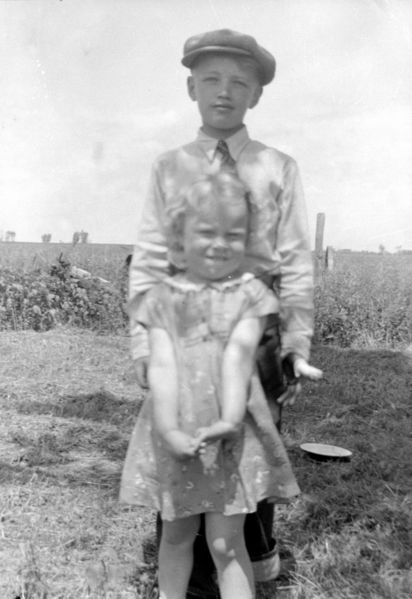 Poor lad — broken a thumb at such a young age, then made to get all dressed up for family. He does appear to have a brace (the black in his palm), which would indicate a pretty serious break, and the lack of our ultra-modern materials means it looks a lot worse than if you broke it today. These days, we have flesh-colored or transparent high-strength tape and carbon-fiber braces that make it all but invisible. In the thirties, they had cloth tape — or that might even be a plaster cast. Also, remember this farm was probably a good 5 to 10 miles from the nearest town…if they went to a doctor at all. If a neighbor or even dad was handy with medical supplies, the only doctor consulted was a copy of the Modern Home Medical Advisor that came free with $10 of groceries down at the Red Owl.
Poor lad — broken a thumb at such a young age, then made to get all dressed up for family. He does appear to have a brace (the black in his palm), which would indicate a pretty serious break, and the lack of our ultra-modern materials means it looks a lot worse than if you broke it today. These days, we have flesh-colored or transparent high-strength tape and carbon-fiber braces that make it all but invisible. In the thirties, they had cloth tape — or that might even be a plaster cast. Also, remember this farm was probably a good 5 to 10 miles from the nearest town…if they went to a doctor at all. If a neighbor or even dad was handy with medical supplies, the only doctor consulted was a copy of the Modern Home Medical Advisor that came free with $10 of groceries down at the Red Owl.
Howie and his Truck
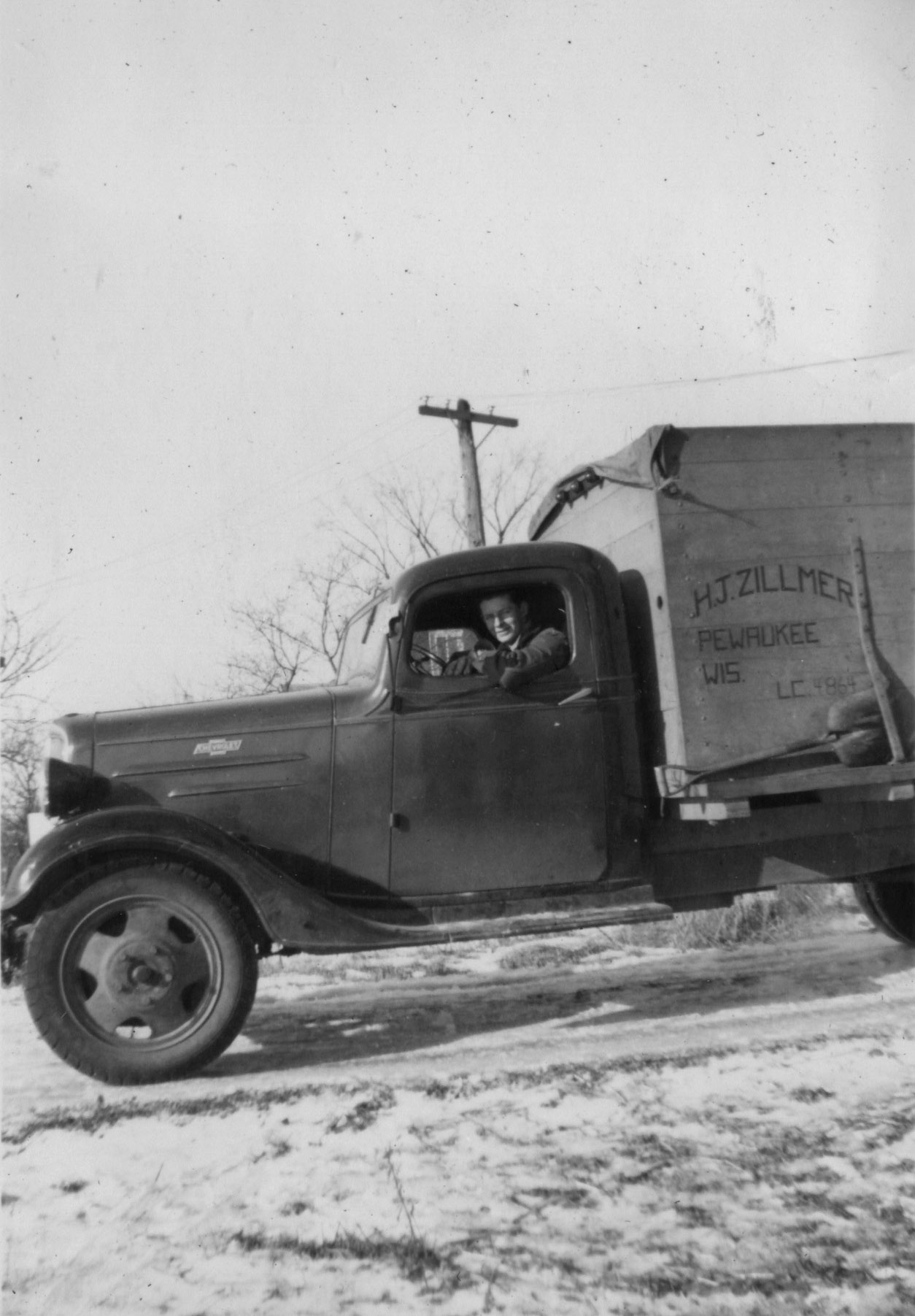 This picture was captioned “Howie.” Mr. Zillmer had a truck, was from Pewaukee, Wisconsin, owned a 1930s-era Chevrolet truck, and was friends with the photographer of this album. That’s about all we know — and with this magic of the internet, can anything more be discovered? Not as much as you might think — Howie could certainly be “Howard Zillmer” — the internet brings us a flyer from a church in Florida that lists Zillmer’s birthday as January third — Florida’s quite a ways away from Wisconsin, though. 2003 brought us the obituary of a Howard Zillmer’s mother, Augusta, who had been born in 1910 and lived in Pewaukee. Howard E Zillmer enlisted in the military in Milwaukee shortly after World War II broke out, but — also in Milwaukee — Howard R Zillmer held out until ’43. Our photogenic Howard, however, looks older than any of the possible Howards on the internet. If internet archives have slowly reached back to the ’40s, maybe eventually we’ll be able to find Howie. Until then, he’s remembered for driving his grain truck past Ruth.
This picture was captioned “Howie.” Mr. Zillmer had a truck, was from Pewaukee, Wisconsin, owned a 1930s-era Chevrolet truck, and was friends with the photographer of this album. That’s about all we know — and with this magic of the internet, can anything more be discovered? Not as much as you might think — Howie could certainly be “Howard Zillmer” — the internet brings us a flyer from a church in Florida that lists Zillmer’s birthday as January third — Florida’s quite a ways away from Wisconsin, though. 2003 brought us the obituary of a Howard Zillmer’s mother, Augusta, who had been born in 1910 and lived in Pewaukee. Howard E Zillmer enlisted in the military in Milwaukee shortly after World War II broke out, but — also in Milwaukee — Howard R Zillmer held out until ’43. Our photogenic Howard, however, looks older than any of the possible Howards on the internet. If internet archives have slowly reached back to the ’40s, maybe eventually we’ll be able to find Howie. Until then, he’s remembered for driving his grain truck past Ruth.
Potatoes!
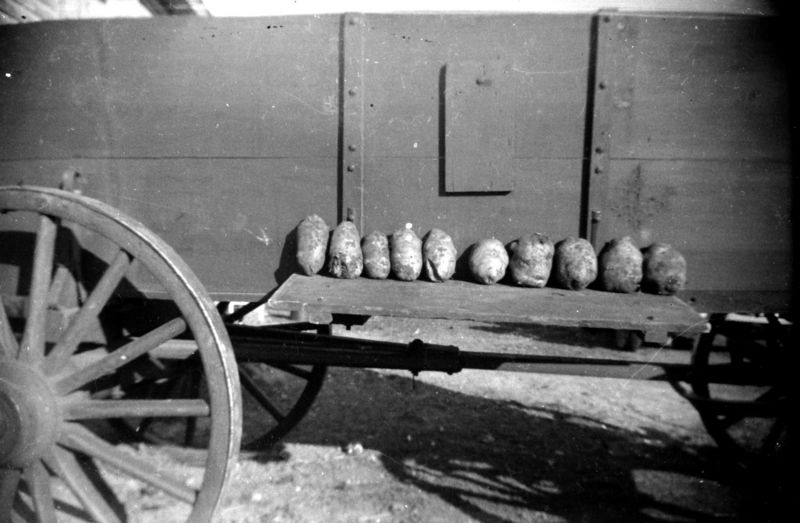 From this collection. Potatoes. What more can I say?
From this collection. Potatoes. What more can I say?
Swimming at Mt. Tello
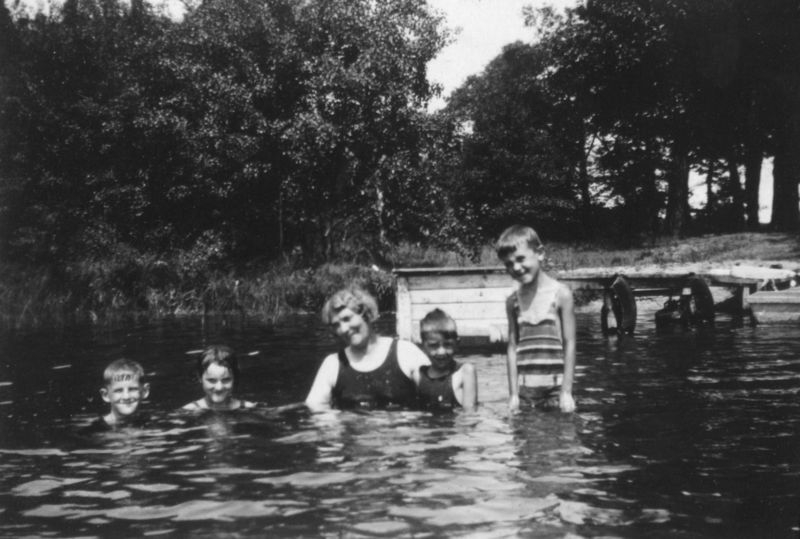
This photo is captioned “At Mt. Tello“. The rest of the series are from Wisconsin, so I assumed there must be a Mount Tello somewhere in the area. Google, sadly, has no results, but it sounds so familiar…Mt. Tello…Tello Mountain…Mount Tello — and a light turns on above my head. Along Highway 23 in central Wisconsin is a small town on a lake/river: Montello. Ruth must have asked, ‘where was this taken?’ and misunderstood the answer.
also: origin of Montello’s name * Montello Lake * downtown Montello * the falls in Montello
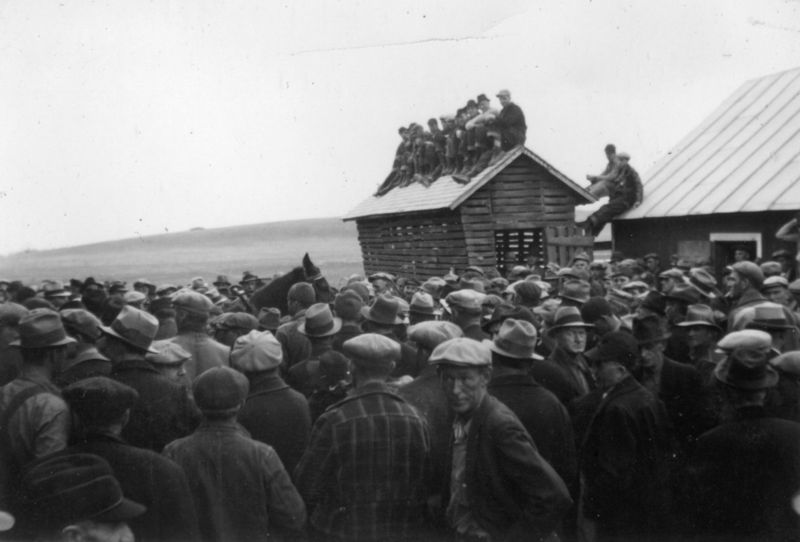 This image, one of two captioned “At Uncle Nick’s Auction,” shows a common sight around the rural USA during the 1930s. No, not just a crowd of fedoras and paperboy hats (although those were quite common, especially at the employment office or the bread lines). Farm foreclosures were driven by the Great Depression, a sluggish economy, a prewar slump due to foreign instability, and the ongoing change from a raw-materials economy to a manufacturing economy. This one appears to have been taken in 1938, after the “heyday” of foreclosures in the early 1930s. Early on, farmers protested and caused ‘penny auctions’ — friends and neighbors ran off genuine bidders, and never bid more than a penny for any lot. By the late 1930s the worst of it was over, some economic reforms were starting to help, and this auction was probably handled better than frantic bank-recoveries earlier in the decade.
This image, one of two captioned “At Uncle Nick’s Auction,” shows a common sight around the rural USA during the 1930s. No, not just a crowd of fedoras and paperboy hats (although those were quite common, especially at the employment office or the bread lines). Farm foreclosures were driven by the Great Depression, a sluggish economy, a prewar slump due to foreign instability, and the ongoing change from a raw-materials economy to a manufacturing economy. This one appears to have been taken in 1938, after the “heyday” of foreclosures in the early 1930s. Early on, farmers protested and caused ‘penny auctions’ — friends and neighbors ran off genuine bidders, and never bid more than a penny for any lot. By the late 1930s the worst of it was over, some economic reforms were starting to help, and this auction was probably handled better than frantic bank-recoveries earlier in the decade.
Also: farmer’s diary * iowa depression * nebraska foreclosures * remembering farm life
